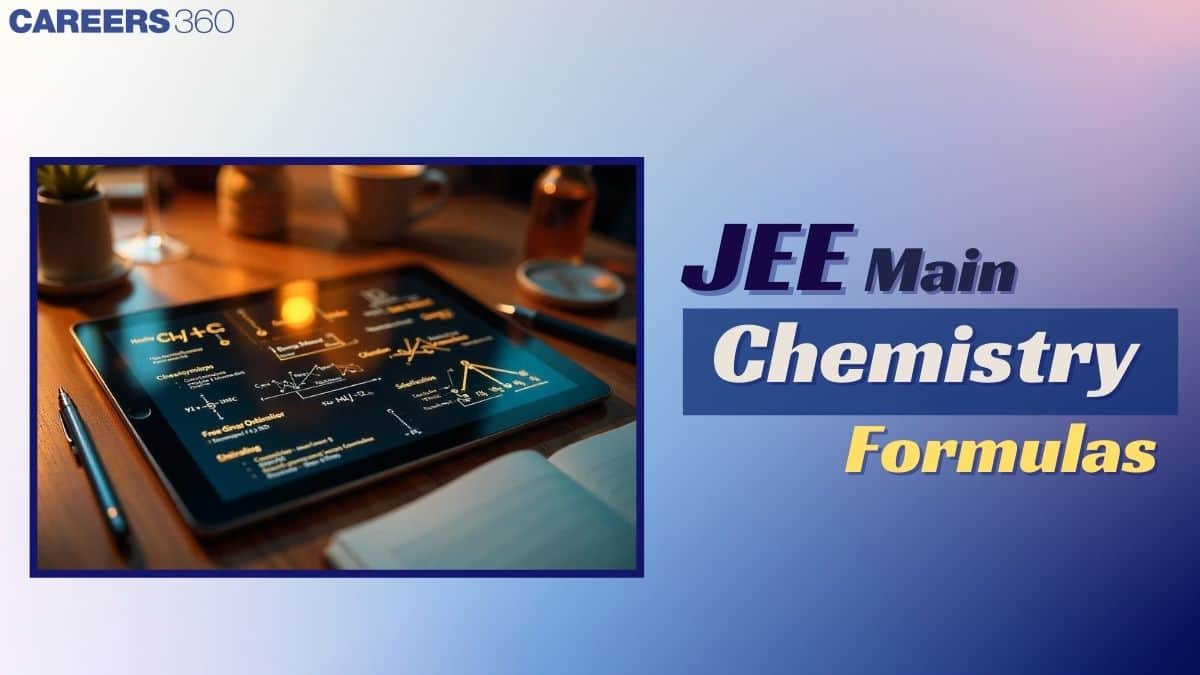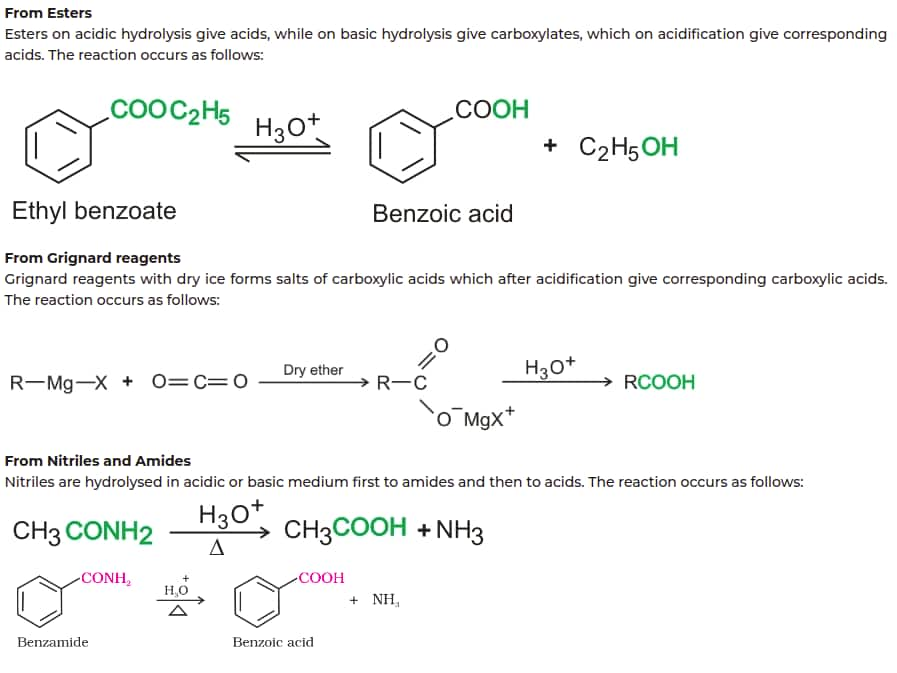UPES B.Tech Admissions 2026
Ranked #43 among Engineering colleges in India by NIRF | Highest Package 1.3 CR , 100% Placements
JEE Main Chemistry Formulas 2026 - The Joint Entrance Exam is one of the most competitive exam of engineering entrance exams. It is divided into three subsections (Physics, Chemistry, Maths). Chemistry is an important subject for JEE Main preparation. Hence, having a list of important formulas for JEE Main Chemistry 2025 is necessary. Every aspirant should have the short notes for JEE Mains that comprise the important formulas. These JEE important formulas for Chemistry help in solving the typical problems easily. The registration process for JEE Main 2026 is now open, and students can apply from 31 October 2025 to 27 November 2025. Session 1 of the exam will be conducted from 21 to 30 January 2026.
This Story also Contains

Download the JEE Main Chemistry Formulas E-Book below:
JEE Mains Chemistry all Formulas PDF Download
There will be a total of 25 questions from Chemistry in JEE Main 2026, all of which have to be attempted. It is further segregated into Physical, Organic, and Inorganic sections. The maximum number of topics has been reduced from this section (chemistry) only. This makes Chemistry easier than before. However, the high-weightage topics for JEE Main remain the same.
Below are important formulas for JEE Main 2026 Chemistry that are helpful for both sessions. Candidates should solve as many Chemistry questions as they can and implement these formulas to remember them quickly. To crack the JEE Main exam with good marks, paste these formulas near the study table and memorise them.
Candidates while studying chemistry, they need to revise and practice the chemical equations and symbols. To some, chemistry is a tough subject, but when candidates practice chemical equations, revise the properties, formulas and symbols, they will have command over the subject. Candidates can check the JEE Main Chemistry formulas below
Some Basic Concepts in chemistry
Atomic Structure
Line Spectrum of Hydrogen-like atoms
$\frac{1}{\lambda}=R Z^2\left(\frac{1}{n_1^2}-\frac{1}{n_2^2}\right)$
Bohr radius of nth orbit:
$\mathrm{r}_{\mathrm{n}}=0.529 \frac{\mathrm{n}^2}{\mathrm{Z}} \mathrm{~A}^0$
Velocity of electron in nth orbit:
$\mathrm{V}_{\mathrm{n}}=\left(2.18 \times 10^6\right) \frac{\mathrm{Z}}{\mathrm{n}} \mathrm{~m} / \mathrm{s}$
where Z is atomic number
Total energy of electron in nth orbit:
$\mathrm{E}_{\mathrm{n}}=-13.6 \frac{\mathrm{Z}^2}{\mathrm{n}^2} \mathrm{eV}=-2.18 \times 10^{-18} \frac{\mathrm{Z}^2}{\mathrm{n}^2} \mathrm{~J}$
where Z is atomic number
Hisenberg Uncertainity Principle: $\Delta x . \Delta P \geq \frac{h}{4 \pi}$
$\mathrm{E}_{\mathrm{n}}=-\frac{1312 \times \mathrm{Z}^2}{\mathrm{n}^2} \mathrm{~kJ} / \mathrm{mol}$
National level exam conducted by VIT University, Vellore | Ranked #16 by NIRF for Engg. | NAAC A++ Accredited
100% Placement Record | Highest CTC 54 LPA | NAAC A++ Accredited | Ranked #62 in India by NIRF Ranking 2025 | JEE & JET Scores Accepted
Chemical Thermodynamics
Work done in a reversible isothermal process
$$
\begin{aligned}
& \mathrm{W}=-2.303 \mathrm{nRT} \log _{10} \frac{\mathrm{~V}_2}{\mathrm{~V}_1} \\
& \mathrm{~W}=-2.303 \mathrm{nRT} \log _{10} \frac{\mathrm{P}_1}{\mathrm{P}_2}
\end{aligned}
$$
Work done in an irreversible isothermal process
Work $=-\mathrm{P}_{\text {ext. }}\left(\mathrm{V}_2-\mathrm{V}_1\right)$
That is, Work $=-\mathrm{P} \times \Delta \mathrm{V}$
$W=\Delta E=n C_V \Delta T$
Enthalpy: $H=U+p V$
First Law of Thermodynamics: $\Delta U=q+W$
$\Delta \mathrm{G}=\Delta \mathrm{H}-\mathrm{T} \Delta(\mathrm{S})$
$\Delta G=-n F E$
Equilibrium
$\mathrm{mA}+\mathrm{nB} \rightleftharpoons \mathrm{pC}+\mathrm{qD}$ $\frac{\mathrm{K}_{\mathrm{f}}}{\mathrm{K}_{\mathrm{b}}}=\frac{[\mathrm{C}]^{\mathrm{p}}[\mathrm{D}]^{\mathrm{q}}}{[\mathrm{A}]^{\mathrm{m}}[\mathrm{B}]^{\mathrm{n}}}=\mathrm{K}_{\mathrm{c}}$
$\mathrm{pH}=-\log _{10}\left[\mathrm{H}^{+}\right]$
$\mathrm{k}_{\mathrm{w}}=\left[\mathrm{H}^{+}\right]\left[\mathrm{OH}^{-}\right]=10^{-14}$
$\mathrm{pH}=\mathrm{pK}_{\mathrm{a}}+\log _{10} \frac{[\text { Salt }]}{\text { Acid }}$
$\mathrm{pOH}=\mathrm{pK}_{\mathrm{b}}+\log _{10} \frac{[\text { Salt }]}{[\text { Base }]}$
ELECTROCHEMISTRY
$\begin{aligned}
& \frac{E_1}{E_2}=\frac{M_1}{M_2} \text { or } \frac{W_1}{W_2}=\frac{Z_1}{Z_2} \\
& E_1=\text { equivalent weight } \\
& E_2=\text { equivalent weight }
\end{aligned}$
W or M = mass deposited
$\begin{aligned} & E_{\text {cell }} \text { or } E M F=\left[E_{\text {red }}(\text { cathode })-E_{\text {red }}(\text { anode })\right] \\ & E_{\text {eell }}^{\circ} \text { or } E M F^{\circ} \\ & =\left[E_{\text {red }}^{\circ}(\text { cathode })-E_{\text {red }}^{\circ}(\text { anode })\right]\end{aligned}$
$\mathrm{E}=\mathrm{E}^{\circ}-\frac{\mathrm{RT}}{\mathrm{nF}} \ln Q$
$\mathrm{xA}+\mathrm{yB} \xrightarrow{\mathrm{ne}^{-}} \mathrm{mC}+\mathrm{nD}$
The emf can be calculated as
$\text { Ecell }=\mathrm{E}^{\circ} \text { cell }-\frac{0.059}{\mathrm{n}} \log \frac{[\mathrm{C}]^{\mathrm{m}}[\mathrm{D}]^{\mathrm{n}}}{[\mathrm{~A}]^x[\mathrm{~B}]^{\mathrm{y}}}$
$\wedge_{\mathrm{m}}=\kappa \times \frac{1000}{\mathrm{c}}$
$\wedge_{\text {eq }}=\frac{1000 \times \kappa}{\mathrm{N}}$
Solutions
Chemical kinetics
Unit of Rate Constant-
$\begin{aligned}
& \text { The differential rate expression for } \mathrm{n}^{\text {th }} \text { order reaction is as follows: } \\
& \qquad-\frac{\mathrm{dx}}{\mathrm{dt}}=\mathrm{k}(\mathrm{a}-\mathrm{x})^{\mathrm{n}} \\
& \text { or } \quad \mathrm{k}=\frac{\mathrm{dx}}{(\mathrm{a}-\mathrm{x})^{\mathrm{n}} \mathrm{dt}}=\frac{(\text { concentration })}{(\text { concentration })^{\mathrm{n}} \text { time }}=(\text { conc. })^{1-\mathrm{n}} \text { time }^{-1}
\end{aligned}$
For the first-order reaction,
$k=\frac{2.303}{t} \log \frac{[\mathrm{R}]_0}{[\mathrm{R}]}$
$t_{1 / 2}=\frac{0.693}{k}$
For any general nth order reaction it is evident that,
$\mathrm{t}_{\frac{1}{2}} \propto[\mathrm{~A}]_0^{1-\mathrm{n}}$
It is to be noted that the above formula is applicable for any general nth-order reaction except $\mathrm{n}=1$.
Arrhenius Equation: $\mathrm{k}=\mathrm{Ae}^{-\mathrm{Ea} / \mathrm{RT}}$
$\log \frac{\mathrm{K}_2}{\mathrm{~K}_1}=\frac{\mathrm{Ea}}{2.303 \mathrm{R}}\left[\frac{1}{\mathrm{~T}_1}-\frac{1}{\mathrm{~T}_2}\right]$
Coordination Compounds
$\mathrm{EAN}=Z-O+2 L$
Where:
$\mathbf{Z}=$ Atomic number of the central metal atom/ion
$\mathbf{O}=$ Oxidation state of the metal atom/ion
L = Number of ligands (or donor atoms) $\times$ number of electrons donated per ligand
Crystal Field Stabilization Energy (CFSE):
Octahedral:
$$
\mathrm{CFSE}=(-0.4 x+0.6 y) \Delta_0
$$
Tetrahedral:
$$
\mathrm{CFSE}=(-0.6 x+0.4 y) \Delta_t
$$
where $x=t_2 g$ electrons, $y=$ e_g electrons
d- & f-Block Elements
Magnetic Moment:
$\mu=\sqrt{n(n+2)} \mathrm{BM}$
Chemical Bonding and Molecular Structure
Formal Charge:
$\text { F.C. }=V-N-\frac{B}{2}$
( $\mathrm{V}=$ valence electrons, $\mathrm{N}=$ non-bonding, $\mathrm{B}=$ bonding electrons)
Bond Order (Molecular Orbital Theory):
$\text { Bond Order }=\frac{\left(N_b-N_a\right)}{2}$
Dipole Moment:
$\mu=q \times d$
( $q=$ charge,$d=$ distance between charges)
Some Basic Principles of Organic Chemistry
Application of Inductive Effect
The decreasing -I effect or increasing +I effect order is as follows:
$\begin{aligned}
& -\mathrm{NH}_3+>-\mathrm{NO}_2>-\mathrm{SO}_2 \mathrm{R}>-\mathrm{CN}>-\mathrm{SO}_3 \mathrm{H}>-\mathrm{CHO}>-\mathrm{CO}>-\mathrm{COOH}>-\mathrm{F}>-\mathrm{COCl}>-\mathrm{CONH}_2>-\mathrm{Cl}>-\mathrm{Br}>-\mathrm{I}>-\mathrm{OR}>-\mathrm{OH}>-\mathrm{NR}_2>-\mathrm{NH}_2> \\
& -\mathrm{C}_6 \mathrm{H}_5>-\mathrm{CH}=\mathrm{CH}_2>-\mathrm{H}
\end{aligned}$
Degree of Unsaturation (DU or IHD):
$\mathrm{DU}=\frac{2 C+2-H+N-X}{2}$
( $\mathrm{C}=$ carbon, $\mathrm{H}=$ hydrogen, $\mathrm{N}=$ nitrogen, $\mathrm{X}=$ halogen)
Hydrocarbons
Carboxylic Acids and Derivatives
Method of Preparation of Carboxylic Acid

Given below are some tips to help you prepare for JEE Main and score good marks in the exam:
1. First, students need to understand the Syllabus and Exam Pattern so that they can refer to the JEE Main syllabus from the official website.
2. Try to identify the important and high-weightage topics and prepare according to that.
3. Create an effective study plan according to your preparation level. Divide your preparation into monthly, weekly, and daily targets and allocate more time to difficult subjects or topics.
4. Students must focus on conceptual clarity; they must understand the logic and derivations behind every formula.
5. Try to solve questions regularly. Solve previous years' JEE Main question papers and attempt mock tests and sample papers regularly.
Students find it difficult to learn formulas for JEE Main, but with the right approach, they can remember them. Given below are some points to remember:
1. Students must try to understand why a formula works and how chemical reactions occur, and their mechanism.
2. Then break down formulas into chapters or topics.
3. To learn these formulas easily, try to make a formula notebook.
4. Sometimes students must try to make Mnemonics and short tricks, as it helps in quick revision.
5. Try to solve as many questions and revise
6. Try to use diagrams and flowcharts.
Frequently Asked Questions (FAQs)
Chemistry has three subparts (Physical, inorganic and organic). Physical chemistry has many numericals based on different formulas.
Yes, Class 12 syllabus carries more than 50% of weightage, so it is important for JEE Main Exam.
JEE Main is an exam conducted for those aspirants who want to take admission in NIITs, IITs and other engineering colleges, and it is also an eligibility test for JEE advance.
On Question asked by student community
Hello,
It is not possible to receive automatic notifications for the forms of JEE Mains SAT and MHT CET. You will need to check the official portals of these exams regularly when the year 2027 approaches. The exam authorities release their application forms through official announcements, and you can stay updated by checking their notices or by following reliable educational sources. You can also set reminders to check updates during the usual application periods so you do not miss any important dates
Hope this helps you.
Hello aspirant,
It is anticipated that registration for the second JEE Main 2026 session would begin during the final week of January and conclude during the final week of February. The second session exam dates are tentatively slated between April 1 and 10, 2026.
For more information, you can visit our site through following link:
https://engineering.careers360.com/articles/jee-mains-session-2-exam-date
Thank you
Hello,
For JEE Main 2026 session 2 (April session), registration is expected to start in the last week of January 2026, closing sometime in February 2026, following the pattern of session 1 registration and the general timeline for future exams, though the official NTA dates will confirm specifics. Here in this article you will find more about JEE Main application.
I hope it will clear your query!!
Hello,
If the ten years question paper file is not opening, it may be due to file corruption, unsupported format or incomplete download. Try downloading the file again and make sure the download completes fully. Check if your device has an updated PDF reader or file viewer. If the file still does not open, try using another device to check whether the file is working. If none of these methods help, you should request a fresh copy of the question paper file.
Hope this helps you.
Hi, to prepare for JEE MAin you can refer to - JEE Main- Top 30 Most Repeated Questions & Topics
https://engineering.careers360.com/download/ebooks/jee-main-top-30-most-repeated-questions-topics
Thankyou
Ranked #43 among Engineering colleges in India by NIRF | Highest Package 1.3 CR , 100% Placements
Among top 100 Universities Globally in the Times Higher Education (THE) Interdisciplinary Science Rankings 2026
Recognized as Institute of Eminence by Govt. of India | NAAC ‘A++’ Grade | Upto 75% Scholarships
Hands on Mentoring and Code Coaching | Cutting Edge Curriculum with Real World Application
Attempt JEE Main online mock test based on the updated syllabus. Check your preparation and identify your weak points.
NAAC A++ Grade | Recognized as Category-1 Deemed to be University by UGC | 41,000 + Alumni Imprints Globally